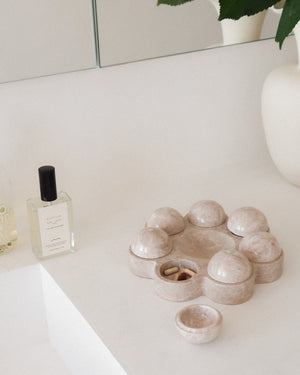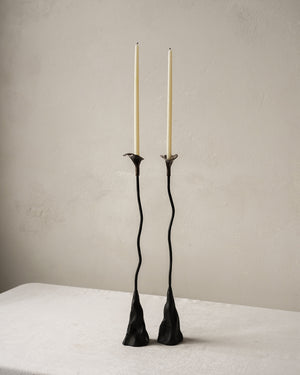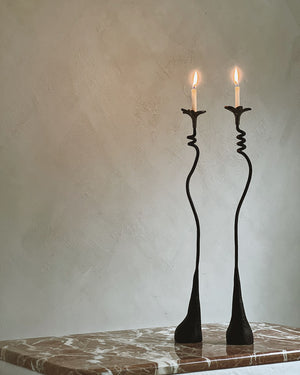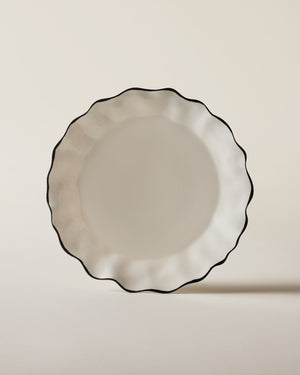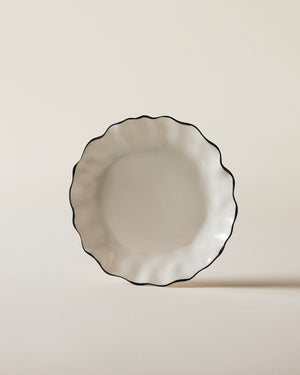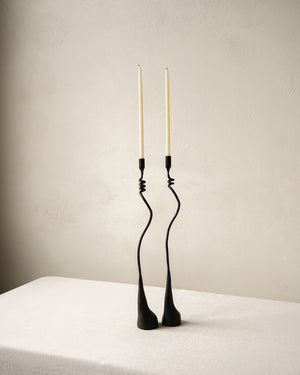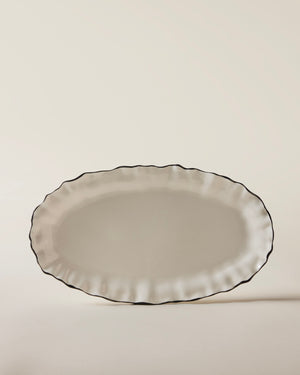THE MAKING OF, WITH ISABELLE VAN ZEIJL

Isabelle Van Zeijl's exclusive series for LES is built around one principle: surrounding oneself with beauty improves our lives immensely. In truth, even the ancient philosophers knew this. "The contemplation of beauty causes the soul to grow wings," wrote Plato in his Symposiums, a text first published in the 4th century B.C.
The idea that beauty can not only transform you but also heal you is central to Isabelle Van Zeijl's work. "Beautiful objects such as art have a really important function in our lives," she says. "They invite us to evolve in that direction, to become as they are. Beauty can educate our souls."

In her exclusive series for LES Collection, which she worked on during the pandemic, Van Zeijl expounded on notions of beauty she has developed for years. In the photographs, which are self-portraits, Van Zeijl wears monumental headdresses made from white paper. The shapes of the headdresses are informed by organic forms Van Zeijl is drawn to in nature, such as orchids, white tulips, and the leaves of plants. Orchids, in particular, have long held fascination for Van Zeijl, who first started photographing herself wearing the flower because of their physical similarity to butterflies. (The Dutch botanist who first brought the plant to the West in the 19th century initially mistook the orchids he discovered in Java for a kaleidoscope of butterflies.) "Like a metaphor for profound change in the cycles of our lives, moving from one state to another, the butterfly's remarkable shape-shifting journey carries an inspiring message that teaches us that growth and transformation need not be traumatic or painful, but rather liberating and joyful," she says.
|
Source by Isabelle Van Zeijl |
Supermodel II by Isabelle Van Zeijl |

Van Zeijl, who works alone, began building each headdress in her studio. She worked with paper because "paper is flexible and limitless to create with." As each sculpture took shape, she would place it on her head and then look at herself in a mirror, making shape changes with scissors. "I took photographs to see how the shape aesthetically developed until it embodied beauty and power," she says. "I aim to reshape and reinvent new forms; I like them to be dramatic and in bloom."

The final headpieces unfurl as if reaching for sunlight. Their size and form elevate Van Zeijl's body, which is nude and covered in fast-drying clay. In the images, she becomes an otherworldly being that is neither flora nor fauna but an entirely new being. Either that or a sculpture found in a secret garden left alone for so many years that it has erupted in layers of moss, ferns, and blossoms.
"I don't want the viewer to see me," Van Zeijl says. "The subject can be anyone."

Although she has previously worked with color, Van Zeijl restricted her palette to white for the LES series. "White is the source of all colors, the origin," she says. Additionally, the color represents renewal, which she thought about a lot during the pandemic.
The clay applied to Van Zeijl's body was intended to give the appearance of marble and capture the spirit of living in the present. The clay would dry within 30 seconds, and Van Zeijl had to capture the images while still wet; she had to race to achieve the poses she wanted before the clay dried. "The series says to embrace or love the current moment," Van Zeijl notes, adding that this was a salient lesson to learn in the past few years. "COVID-19 taught us that life has no guarantees or certainties," she says. "It can change in a moment."
|
Phoenix by Isabelle Van Zeijl |
Domain I by Isabelle Van Zeijl |

The series continues Van Zeijl's desire to create a new language around female beauty. "Female beauty ideals have been hammered out almost exclusively by men," she says. "As a female artist, I took my autonomy back and decided how I want to be seen, not through the eyes of men, but through my own eyes." She notes that the subject of the female body has endured through the ages because it is compelling. It is only very recently, however, that women were given the power to control how they are depicted in art. In the series for LES, Van Zeijl's nude form is a source of strength and growth as opposed to a site for male desire.

In a sense, Van Zeijl has wiped the slate of art history clean and begun again from scratch, crafting an idea of beauty that is inclusive and original rather than based on tired notions informed by diet, culture, sex, and forbidden lust. Her self-portraits for LES Collection, paradoxically simple and complex, have the effect of slowing down one's heartbeat. "When we surround ourselves with beautiful objects, we as humans want to become more beautiful," she says.
|
Spirit by Isabelle van Zeijl |

